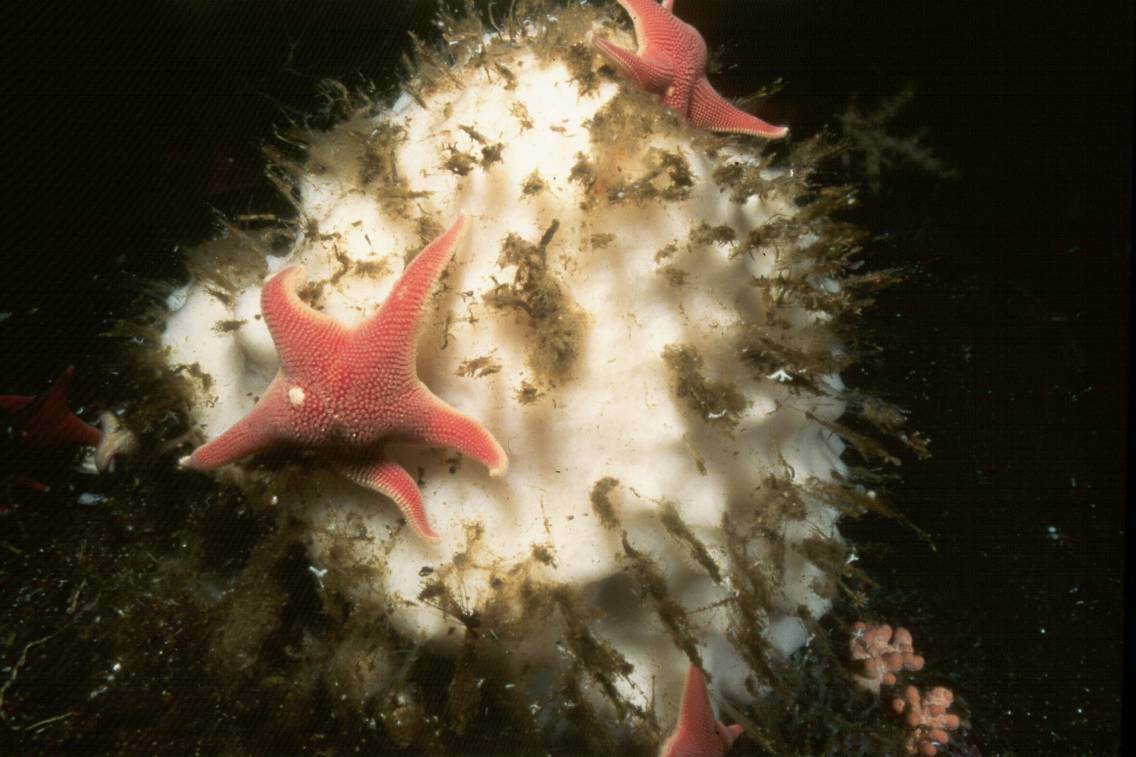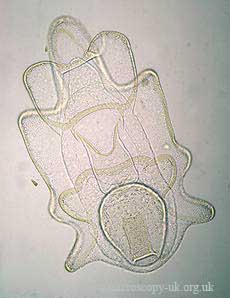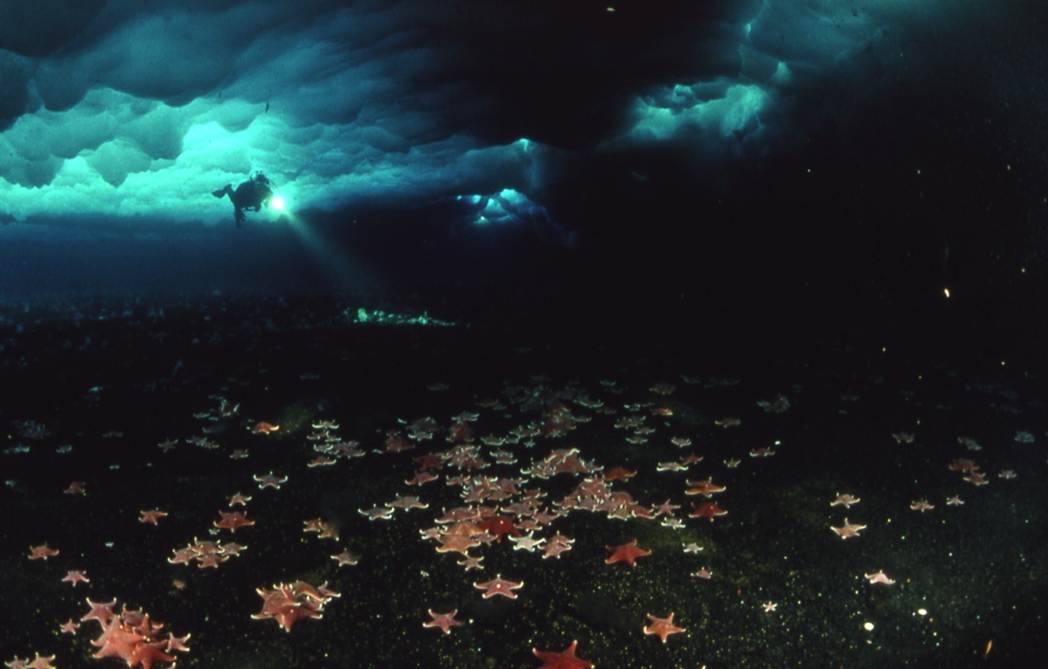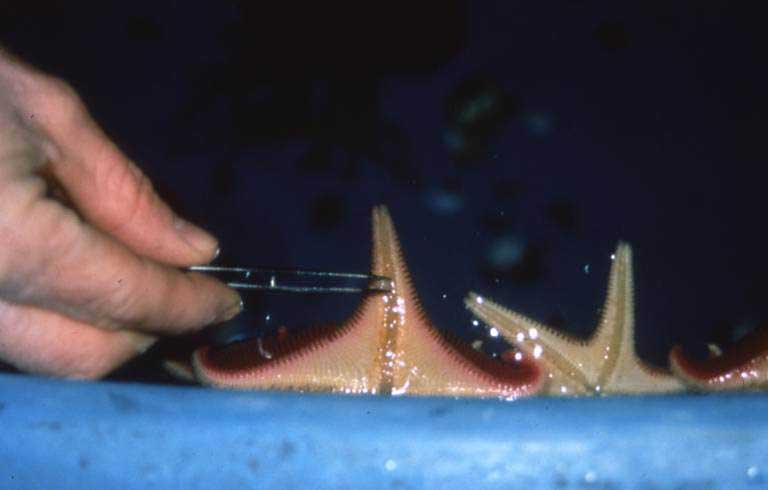
Sea stars, also known as starfish (this latter term is a bit of misnomer considering they are certainly not "fish"), are common sea floor animals that are found in all the world's oceans. Most have five rays or arms, but others can muster as many as twenty-five to thirty as saw my previous "Unexpected Surprises" post. Their arms are lined with legions of tiny tube-feet that operate using a unique hydraulic plumbing system that squeezes water through tubes with tiny valves that open and shut. The tube-feet serve primarily for locomotion, but also play a role in food capture and sensing prey.
Sea stars employ a remarkable method of feeding. Your grandmother would not approve. Instead of swallowing their food they have the ability to slide their stomach out of their mouth and lay it on their prey. I tell my invertebrate zoology students that it is a good thing that humans have not followed suit. Can you imagine the dining scene in a restaurant? The sea star's stomach tissues are thin enough to slide between the tightly closed shells of a clam and digest its soft body tissues right within its own shell. And as imaged above, sea stars can sit on their meal, in this case a sponge, and leisurely snack away at the sponge's soft tissue.

Reproduction in sea stars typically involves separately sexed individuals producing millions of tiny eggs or sperm that are spawned simultaneously into the sea where fertilization occurs. The fertilized eggs develop into larvae equipped with little hairs – or cilia - that propel them through the water and aid in feeding on tiny plant cells called phytoplankton (See the image left). And yet, some sea stars do things quite differently. Rather than release their gametes into the sea, they roost their eggs like a chicken - a process called "brooding."
When I first visited the Ross Sea, Antarctica, I was a member of team led by sea star expert John Pearse. One of our research goals was to determine if brooding was in fact the dominant mode of reproduction in sea stars and other marine invertebrates. Early Antarctic marine biologists had predicted this would be case in cold polar water which would slow down larval development and render swimming larvae vulnerable to starvation and predators. In fact, while we found that brooding in Antarctic sea stars was not unusual, our team discovered several sea stars species that were quite content to toss their eggs and sperm into the water where their swimming larvae developed over a period of several months. They seemed to be doing just fine. Indeed, those species releasing their young into the sea were among the most numerous of sea stars.
Antarctic sea stars are especially important for a number of reasons. First and foremost, unlike other regions of the world, in Antarctica they are the top predators. Paul Dayton, a pioneer of Antarctic marine ecology, discovered that Antarctic sea stars shape the very communities in which they live. For example, he described the sea floor communities in McMurdo Sound as dominated by sponges. Most of the sponges grew very slowly, but one grew remarkably fast. 
Here, several different species of sea stars, including some that ate only sponges (called spongivores), played pivotal roles in ensuring that the rapidly growing sponge did not crowd out all the other sponges and dominate the sea floor. One beautiful deep red sea star, Odontaster validus, was a key player in the community that Paul Dayton studied. It not only ate some of the fast growing sponge itself, but it also consumed the larvae and adults of the spongivorous sea stars – keeping their populations in check. This earned Odontaster the right to be considered a "keystone species", that is, a species that has a dramatic impact on the diversity of a community.
At Palmer Station, Odontaster validus is one of the stars of our research program. For many years our team has used this sea star as a model species to test the chemical feeding deterrent properties of various 
Antarctic marine invertebrates and algae. The reason for the popularity of Odontaster is not only its ecological importance – but that it loves to climb up the sides of our seawater tanks and then spread out– upside down – with the undersides of its arms and their outstretched tube-feet positioned against the air-water interface. This allows members of our team to take bits of tissue or food pellets containing extracted chemistry and gently place them on the outstretched tube-feet. If the sea stars don't like the taste they quickly drop the tissue or pellet off the side of their arm – or if they like it – they carry it their mouth. It's the perfect taste test!
We can count our lucky stars for Odontaster validus. Let's hope the focus of our team's current research at Palmer Station, ocean acidification and warming, do not take a toll on these wondrous, yet potentially very vulnerable animals.